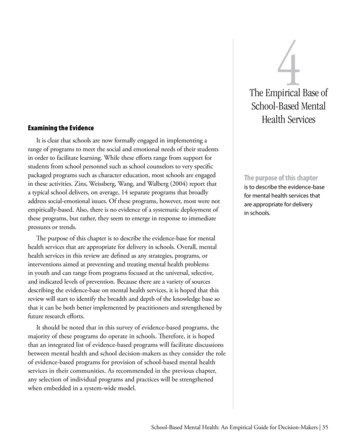
Transcription
4The Empirical Base ofSchool-Based MentalHealth ServicesExamining the EvidenceIt is clear that schools are now formally engaged in implementing arange of programs to meet the social and emotional needs of their studentsin order to facilitate learning. While these efforts range from support forstudents from school personnel such as school counselors to very specificpackaged programs such as character education, most schools are engagedin these activities. Zins, Weissberg, Wang, and Walberg (2004) report thata typical school delivers, on average, 14 separate programs that broadlyaddress social-emotional issues. Of these programs, however, most were notempirically-based. Also, there is no evidence of a systematic deployment ofthese programs, but rather, they seem to emerge in response to immediatepressures or trends.The purpose of this chapteris to describe the evidence-basefor mental health services thatare appropriate for deliveryin schools.The purpose of this chapter is to describe the evidence-base for mentalhealth services that are appropriate for delivery in schools. Overall, mentalhealth services in this review are defined as any strategies, programs, orinterventions aimed at preventing and treating mental health problemsin youth and can range from programs focused at the universal, selective,and indicated levels of prevention. Because there are a variety of sourcesdescribing the evidence-base on mental health services, it is hoped that thisreview will start to identify the breadth and depth of the knowledge base sothat it can be both better implemented by practitioners and strengthened byfuture research efforts.It should be noted that in this survey of evidence-based programs, themajority of these programs do operate in schools. Therefore, it is hopedthat an integrated list of evidence-based programs will facilitate discussionsbetween mental health and school decision-makers as they consider the roleof evidence-based programs for provision of school-based mental healthservices in their communities. As recommended in the previous chapter,any selection of individual programs and practices will be strengthenedwhen embedded in a system-wide model.School-Based Mental Health: An Empirical Guide for Decision-Makers 35
Chapter 4: The Empirical Base of School-Based Mental Health ServicesMethodThe review consisted of an examination ofSAMHSA maintains a web-basedNational Registry of Evidencebased Programs and Practices.Programs listed in this registry areclassified as either model, effective,or promising. existing compendia of empirically-supported programs (N 7), a web-based resource describing established and probably efficaciousapproaches for four specific disorders, four articles summarizing empirically-based programs, and recently published articles identifying recent developments and resourcesin SBMH.Compendia of Empirically-Supported ProgramsSeven lists of empirically-supported mental health programs for childrenwere selected for this review. The following comprise the best known, andmost frequently referenced listings: (1) Substance Abuse and Mental HealthServices Administration (SAMHSA), (2) Collaborative for Academic, Social,and Emotional Learning (CASEL), (3) U.S. Department of Education(USDOE), (4) Prevention Research Center for the Promotion of HumanDevelopment at Penn State, (5) Center for the Study and Preventionof Violence (CSPV), (6) Center for School Mental Health Assistance(CSMHA), and (7) Washington State Institute for Public Policy.1. Substance Abuse and Mental Health Services Administration (SAMHSA)Over the past several years, the Substance Abuse and Mental HealthServices Administration (SAMHSA) has maintained a web-based NationalRegistry of Evidence-based Programs and Practices (NREPP). To be listed onthis registry, program candidates submit published and unpublished programmaterials to NREPP for review by teams of scientists who rate each programaccording to 15 criteria of scientific soundness (see Table 4.1 for a descriptionof these criteria). Though all programs are scored on each of the 15 ratingparameters, scores that determine program classification as either model,effective, or promising are based on ratings of integrity and utility, which serveas summaries for the other 13 criteria.To be designated a Model Program by SAMHSA, a program must be ratedas effective (based on the criteria of scientific soundness) and developers musthave the capacity and have coordinated and agreed with SAMHSA to providequality materials, training, and technical assistance to practitioners whowish to adopt their programs. Effective Programs have met all the criteria of amodel program except developers have yet to agree to work with SAMHSAto support broad-based dissemination of their programs but may disseminatetheir programs themselves. Promising Programs have been evaluated and arescientifically defensible but do not yet have sufficient scientific support to meetstandards set by SAMHSA for designation as an effective or model program36 School-Based Mental Health: An Empirical Guide for Decision-Makers
Chapter 4: The Empirical Base of School-Based Mental Health ServicesTable 4.1Rating criteria for programs submitted for review to SAMHSA’s National Registry ofEvidence-Based Programs and Practices (Schinke, Brounstein, & Gardner, 2002, p. 15)TheoryThe degree to which programs reflect clear, well-articulated principlesabout behavior and how it can be changed.Intervention fidelityHow the program ensures consistent delivery.Process evaluationWhether program implementation was measured.Sampling strategyand implementationHow well the program selected its participants and how well theyreceived it.AttritionWhether the program retained participants during its evaluation.Outcome measuresThe relevance and quality of evaluation measures.Missing dataHow the developers addressed incomplete measurements.Data collectionThe manner in which data were gathered.AnalysisThe appropriateness and technical adequacy of data analyses.Other plausiblethreats to validityThe degree to which the evaluation considers other explanations forprogram effects.ReplicationsNumber of times the program has been used in the field.DisseminationcapabilityWhether program materials are ready for implementation by others inthe field.Cultural- and ageappropriatenessThe degree to which the program addresses different ethnic-racial andage groups.IntegrityOverall level of confidence of the scientific rigor of the evaluation.UtilityOverall pattern of program findings to inform theory and practice(Schinke, Brounstein, & Gardner, 2002). In early 2006, the website listed 66model, 37 effective, and 55 promising programs. Of the 66 model programslisted, 56 (85%) focus on children and/or their parents, and these programs arediscussed in the results section of this chaper.In 2006, SAMHSA will be revising its review criteria for programseligible for the National Registry of Evidence-Based Programs and Practices(NREPP) and expanding the registry to include population-, policy- andsystem-level outcome ratings for interventions (Request for Comments;NREPP, 2005). All programs currently listed within the registry will be rereviewed under the new criteria. The 16 new review criteria for programsaimed at individual-level outcomes are provided in Appendix E. Thedefinitions of the expanded areas of population-, policy-, and systems-leveloutcomes and the 12 review criteria for these outcomes are provided inAppendix F.School-Based Mental Health: An Empirical Guide for Decision-Makers 37
Chapter 4: The Empirical Base of School-Based Mental Health Services2. Collaborative for Academic, Social, and Emotional Learning (CASEL)In March 2003, the Collaborative for Academic, Social, and EmotionalLearning (CASEL) issued a report on evidence-based social and emotionallearning programs.The common core of the 80programs selected by CASEL isthat they all increased children’ssense of connectedness orattachment to school andincreased skills for setting goals,solving problems, achievingself discipline, or characterdevelopment or responsibility.Founded in 1994, CASEL’s mission is to enhance children’s success inschool and life by promoting coordinated, evidence-based social, emotional,and academic learning as an essential part of education from preschoolthough high school. To help achieve this mission, CASEL collaborates withan international network of researchers and practitioners in the fields ofsocial and emotional learning, prevention, positive youth development, andeducation reform to promote social and emotional learning efforts in schools.CASEL searched the extant literature and asked for nominations ofevidence-based programs that provide curriculum for schools to use toincrease the social and emotional competency of the general studentpopulation. They identified 242 programs for review, and selected onlythose programs (a) that are school-based and provide curriculum (of atleast eight lessons) for teachers to deliver to the general student population;(b) whose curriculum covers two consecutive grades or provides a structurethat promotes lesson reinforcement beyond the first year; and (c) areavailable nationally.Of the 242 programs reviewed, 80 met the specified criteria. Of the 80programs, only 11 or 14% of the programs met the highest level of scientificrigor set by CASEL: multiple studies (using different samples) that documentpositive behavioral outcomes at post-testing, with at least one study indicatingpositive behavioral impact at least one year after the intervention ended.The common core of the 80 programs selected by CASEL is that theyall increased children’s sense of connectedness or attachment to school andincreased skills for setting goals, solving problems, achieving self discipline,character development, or responsibility. The 11 programs meeting thehighest level of rigor are described in the results section of this chapter.3. U. S. Department of Education (USDOE)In 1998, a panel comprised of 15 experts in safe, disciplined, and drugfree schools acting on behalf of the Department of Education’s Officeof Educational Research and Improvement (OERI) began to documenteducational programs effective in combating both substance abuse andviolence among youth. Applications were solicited from any program sponsorwho believed his or her program might meet the review criteria. Of the 124programs reviewed, 33 programs were designated as “promising” and nineprograms were designated as exemplary. There were seven criteria that hadto be met in order for a program to be considered exemplary: (a) evidence of38 School-Based Mental Health: An Empirical Guide for Decision-Makers
Chapter 4: The Empirical Base of School-Based Mental Health Servicesefficacy, (b) quality of the program goals, (c) a sound rationale, (d) programcontent is appropriate for intended population, (e) program implementationis sound, (f) program integrates into the educational mission of schools, and(g) the program can be replicated. The monograph describing these programswas published in 2001, and the nine programs classified as exemplary aredescribed in the results section of this chapter.4. Prevention Research Center for the Promotion of Human Developmentat Penn StateWritten in 2000 by Greenberg, Domitrovich, and Bumbarger, thisreview included effective universal, selective, and indicated preventionprograms that were found to produce improvements in specific psychologicalsymptomatology or in factors generally considered to be directly associatedwith increased risk for child mental disorders. Because of this, studies wereincluded if the child showed early problems or was identified as being highrisk for developing a later disorder; studies were excluded if the children wereformally identified as having a DSM diagnosis. Programs were included ifthey had been evaluated using either a randomized-trial design or a quasiexperimental design that used an adequate comparison group. Studies wererequired to have both pre- and post-findings, and preferably follow-up datato examine the duration and stability of program effects. In addition, it wasrequired that the programs have a written manual that specifies the modeland procedures to be used in the intervention. Finally, it was necessary toclearly specify the sample and their behavioral and social characteristics.Programs were identified through an extensive review of the literature andreputable internet sources (i.e., Centers for Disease Control and Prevention,NIMH Prevention Research Center). Over 130 programs were identified,34 of which met criteria for inclusion in the review. Those 34 programs aredescribed in the results section of this chapter.5. Center for the Study and Prevention of Violence (CSPV)In 1996, the Center for the Study and Prevention of Violence (CSPV), atthe University of Colorado at Boulder, began an initiative to identify violenceprevention programs that are effective. The project, called Blueprints forViolence Prevention, has identified 11 prevention and intervention programsthat meet criteria for effectiveness. To be classified as a model program or aBlueprint program, the program must have met three criteria: (a) empiricalevidence of prevention effect using a strong research design, (b) a documentedsustained effect overtime, and (c) multiple site replications. While modelprograms must meet all three criteria (n 11), programs classified as promisingmust meet only the first criterion (n 16). The 11 model programs selected byCSPV are described in the results section of this chapter.Written in 2000 by Greenberg,Domitrovich, and Bumbarger,this review included effectiveuniversal, selective, and indicatedprevention programs that werefound to produce improvementsin specific psychologicalsymptomatology or in factorsgenerally considered to bedirectly associated with increasedrisk for child mental disorders.The project, called Blueprintsfor Violence Prevention, hasidentified 11 prevention andintervention programs that meetcriteria for effectiveness.School-Based Mental Health: An Empirical Guide for Decision-Makers 39
Chapter 4: The Empirical Base of School-Based Mental Health Services6. Center for School Mental Health Assistance (CSMHA)The Center for School MentalHealth Assistance (2002) reviewedseveral sources of empiricallysupported interventions toproduce their own overview ofinterventions believed suitable foradaptation and implementationin schools.The Center for School Mental Health Assistance (2002) reviewed severalsources of empirically-supported interventions to produce their own overviewof interventions believed suitable for adaptation and implementation inschools. However the criteria for making this determination were notexplicit. Their list of programs, therefore, included mostly behavioral orcognitive-behavioral interventions that were most likely covered by otherorganizations distilling empirically-based interventions.CSMHA’s sixteen-page document presents a description of 40 programsdivided by diagnostic condition (i.e., anxiety, depression, and conductproblems) and by prevention level; indicated (n 12), selective (n 12), anduniversal (n 16), and may be a useful resource for practitioners. Overall,approximately 8% of the indicated programs, 42% of the selective programs,and 69% of the universal programs or updated versions of these programs arecontained in the description of programs in the results section of this chapter.The titles of the programs contained within the CSMHA document arelisted in Appendix A. The lack of concordance between the CSMHA listand the list of programs created by other sources reflects not only the rapidevolution of new approaches and packaged programs, but also the increases inthe empirical rigor required by more recent reviews.The Washington State Institute forPublic Policy issued a report on thebenefits and cost of evidence-basedprograms that focused on reducingnegative social outcomes.7. Washington State Institute for Public Policy (WSIPP)The Washington State Institute for Public Policy issued a report on thebenefits and cost of evidence-based programs (Aos, Lieb, Mayfield, Miller,& Pennucci, 2004). As mandated by the Washington State Legislature, thisreport focused on a limited number of programs and only those approachesthat focused on reducing the following negative social outcomes for youth:(a) crime, (b) substance abuse, (c) teen pregnancy, (d) suicide, (e) childabuse and neglect, and (f ) increasing the positive social outcome ofeducational attainment.To be included in this analysis, a program or approach had to haveone rigorous evaluation that targeted one of the six outcomes listed aboveand be applicable to real world settings. Additionally, some programs andapproaches were excluded because the measured outcomes could not bemonetized. For example, although one program documented symptomreduction on a scale that measured psychopathology (e.g., changes on theChild Behavior Checklist), the change in score could not be associatedwith a monetary amount and therefore the program could not be part ofthe WSIPP analysis. Changes in standardized scale scores (i.e., symptomreduction) is a common outcome tool for mental health researchers,suggesting that many mental health programs may have been excluded fromthe WSIPP analysis due to the monetary measurement requirement.40 School-Based Mental Health: An Empirical Guide for Decision-Makers
Chapter 4: The Empirical Base of School-Based Mental Health ServicesThe analysis yielded benefit minus cost information for 61 evidencebased programs and approaches. The 61 programs are listed in Appendix B,along with the benefit minus cost estimate per youth, the number of studiesor trials used to calculate the cost-benefit analysis, and the social outcomesinfluenced by each program. Nineteen (31%) of the program/approachesdescribed by WSIPP also appear in one of the other compendia of programs(see figure 4.1).figure 4.1Programs Described by WSIPP Listed in CompendiaPrograms ListedAdolescent Transitions Program (ATP) 1,938All Stars 120Big Brothers/Big Sisters 2,822CASASTART( 610)Child Development Project 432Families that Care: Guiding Good Choices 6,918Family Matters 1,092Functional Family Therapy 26,216Good Behavior Game 196Life Skills Training 717Multidimensional Treatment Foster Care 24,290Multisystemic Therapy (MST) 9,316Nurse-Family Partnership Program 17,180Project ALERT 54Project Northland 1,423Project TNT: Towards No Tobacco Use 274Seattle Social Development Project 9,837( 18)Start Taking Alcohol Risks Seriously (STARS) for FamiliesThe Strengthening Families Program: For Parents and Youth 5,805 0 5,000 10,000 15,000 20,000 25,000 30,000Benefit-Cost Estimate per YouthWhat is especially interesting about this compendium is the uniqueapproach taken to include programs. WSIPP clearly states that they wantedprograms targeted at specific outcomes rather than programs that may fitinto a school or be classified as a mental health program. For example, theytargeted empirically-supported programs that reduce crimes committedby adolescents. While committing a crime would certainly be considereda negative outcome and is often considered poor functioning for a teenattending a mental health program, is a program targeting crime reductionSchool-Based Mental Health: An Empirical Guide for Decision-Makers 41
Chapter 4: The Empirical Base of School-Based Mental Health Servicesa mental health program? Is a program that targets the prevention of teenpregnancy a “mental health program?” The approach adopted by WSIPPpoints to the broad array of outcomes and functioning typically subsumedunder the topic of mental health interventions.www.effectivechildtherapy.comdefines and summarizes theestablished and “probablyefficacious” treatments for thefollowing categories of disorders:Anxiety, Depression, AttentionDeficit Hyperactivity Disorder, andConduct/Oppositional Problems.Web-Based Services Guide for Consumers and PractitionersA website to inform the general public as well as practitioners regardingthe most up to date information about mental health practice for childrenand adolescents has been created through a partnership between the Societyof Clinical Child and Adolescent Psychology (Division 53 of the AmericanPsychological Association) and the Network on Youth Mental Health fundedby the MacArthur Foundation. This web site (www.effectivechildtherapy.com) defines and summarizes the established and “probably efficacious”treatments for the following categories of disorders: Anxiety, Depression,Attention Deficit Hyperactivity Disorder, and Conduct/OppositionalProblems. Under the heading of Anxiety for example, eight associateddisorders are listed including Generalized Anxiety. While there are no wellestablished treatments described for this disorder, cognitive behavioraltherapy, family anxiety management, modeling, and relaxation training aredescribed under the “probably efficacious” treatment heading.This is a beneficial resource for the public and practitioners wanting aquick summary of effective treatment options for a variety of diagnosticconditions. The number of disorders covered by this site may be expandedin the near future (Weisz et al., 2005). Because this site only providesoverarching summaries and does not describe the research or list specificprograms, the descriptions from this site could not be integrated into theresults section of this chapter.The articles selected gobeyond identifying individualprograms, but rather seek toglean evidence-based strategiesthat cut across programs.Articles that Discuss and Summarize Empirically-Supported School-Based MentalHealth ApproachesOur review searched out critiques of evidence-based literature thatidentified common or core features of evidence-based practice. The articlesselected—and described below—go beyond identifying individual programs,but rather seek to glean evidence-based strategies that cut across programs.1. Rones and Hoagwood (2000) and Hoagwood (2006)In order to assess the empirical support for school-based mental healthprograms, Rones and Hoagwood (2000) conducted a review of the literaturepublished between 1985 and 1999. To be included as an empiricallysupported school-based mental health program, the study must haveutilized a rigorous design and included a control group or multiple baselineapproach. The study also had to include a school-based service, defined as“any program, intervention, or strategy applied in a school setting that was42 School-Based Mental Health: An Empirical Guide for Decision-Makers
Chapter 4: The Empirical Base of School-Based Mental Health Servicesspecifically designed to influence students’ emotional, behavioral, or socialfunctioning” (p. 224). Of the 5,128 entries retrieved, less than 1% (n 47)of the studies met the requirement of having a rigorous research design.The remaining empirical studies were categorized as describing 37 strategiesfocusing on either emotional or behavior problems (n 4), depression(n 5), conduct problems (n 22), stress (n 2), or substance abuseproblems (n 12). The outcome domains of each study were categorized asfocusing on (a) reducing symptoms, (b) increasing functioning, (c) describingservices/systems, or (d) a combination of these.Of the 37 strategies and interventions described by the 47 studies, 20%(n 7) were found to be ineffective at treating the targeted problem. Theremaining strategies were found to be either effective (35%, n 13), mixedin their effectiveness (32%, n 12), or a combination of effective on someoutcomes and not on others (13%, n 5; see Appendix C for a list of thestrategies described in this review).The authors summarized factors associated with the effectiveness ofthe empirically-supported strategies (see in Table 4.2). The first factorwas an association between program effectiveness and consistent programimplementation; the second factor was the use of multi-componentprograms that targeted the ecology of the whole child. Three effectiveprevention interventions, for example, targeted parents, teachers, and peersin the intervention. Program effectiveness was also associated with multipleapproaches to changing behavior, such as informational presentationscombined with skill training. It appears that these multiple formats weresuccessful because they focused on the change agents that were theoreticallylinked to the target behaviors. A related factor was that programs with thestrongest evidence of an impact were those directed toward changing specificbehaviors and skills associated with the targeted problem (e.g., depression,conduct problems), while more general activities such as field trips did notseem to enhance the intervention.table 4.2Factors Associated withProgram Effectiveness (Rones &Hoagwood, 2000)1. Consistent implementation2. Multi-component programs(child, teacher, and parentcomponents)3. Multiple approaches(informational sessionscombined with skill training)4. Targeting specific behaviorsand skills5. Developmentally-appropriatestrategies6. Strategies integrated into theclassroom curriculumThe final factor associated with the effectiveness of a strategy was theintegration of the program into the general classroom curriculum. That is,mental health programs delivered as an integral part of the classroom ratherthan as a separate and specialized session were associated with more positiveoutcomes. This suggests the importance of the integration of services withinthe normal routine of the school in order for the programs not only to beeffective but sustained.In a more recent review of the empirical literature, Hoagwood (2006)examined over 2,000 articles produced between 1990 and 2004. Herexamination revealed that 63 articles ( 3%) met her criteria of being arigorously tested intervention dealing with mental health problems inSchool-Based Mental Health: An Empirical Guide for Decision-Makers 43
Chapter 4: The Empirical Base of School-Based Mental Health Serviceschildren. Twenty-three of these studies (37%) tested the effects of a programon both academic and mental health outcomes and 14 of these studiesfound an impact on both types of outcomes. The remaining 40 studies(63%) examined only mental health outcomes with only 38 demonstratingeffectiveness in this area. Additionally, the majority of studies (74%) wereconducted with young children while only six studies focused on middle orhigh school populations.2. Browne, Gafni, Roberts, Byrne, and Majumdar (2004)To determine common elements of mental health programs aimedat providing preventive or early intervention services to at-risk children,Browne, Gafni, Roberts, Byrne, and Majumdar (2004) synthesized23 reviews describing the empirical literature on prevention strategiesimplemented in or involving schools. These reviews were published between1984 and 2000 and represent hundreds of studies. The common elements ofeffective prevention and early intervention programs described in this analysisare presented in Table 4.3.table 4.3Common Elements of Prevention and Early Intervention Programs(Browne et al., 2004)1. Programs aimed at developing protective factors have shown greater positive resultsthan programs aimed at reducing pre-existing negative behaviors, but vary by age,gender, and ethnicity of children2. Younger children show greater positive results than older children, but some programsare effective for older children3. Programs directed to address a specific problem have greater effect than broad,unfocused interventions4. Programming that has multiple elements involving family, school, and community aremore likely to be successful than efforts aimed at a single domain5. Strategies were enhanced when based on and informed by sound theoreticalfoundations6. Fear-inducing tactics and delivering information in only a didactic format were generallyless effective7. Long-term strategies are more effective than short-term strategies when they have thecontinued presence of appropriate adult staff or mentors3. Greenberg, Weissberg, O’Brien, Zins, Fredricks, Resnik, et al. (2003)Greenberg and colleagues (2003) conducted a synthesis of the empiricalliterature on strategies aimed at increasing positive youth developmentand mental health; decreasing substance use; antisocial behavior, schoolnonattendance, and drug use; and the influences on learning and academicperformance. They concluded that there is a solid research base indicatingthat well-designed, well-implemented, school-based prevention and youth44 School-Based Mental Health: An Empirical Guide for Decision-Makers
Chapter 4: The Empirical Base of School-Based Mental Health Servicesdevelopment programming canpositively influence a diverse array ofsocial, health, and academic outcomes.This synthesis found that key strategiesfor effective school-based preventionprogramming involve student-focused,relationship-oriented, and classroomand school-level organizational changes(see Table 4.4).4. Weisz, Sandler, Durlak, and Anton (2005)In this recent article, Weisz andcolleagues (2005) propose linkingmental health prevention and treatmentwithin an integrated model. Part of theresearch agenda to achieve this modelcalls for the continued developmentand wider implementation of evidencebased prevention and treatmentinterventions. They conclude thatmore than 500 discrete, namedpsychotherapies are now practicedwith children and more than 1,500outcome studies have been conducted.The authors summarize the resultsof numerous meta analyses onmental health treatments (primarilypsychotherapy studies) and these resultsare presented in Table 4.5.table 4.4Key strategies for effective school-based prevention programming involve the followingstudent-focused, relationship-oriented, and classroom- and school-level organizationalchanges (Greenberg et al., 2003, p. 470)1. Teach children to apply social a
(CSMHA), and (7) Washington State Institute for Public Policy. 1. Substance Abuse and Mental Health Services Administration (SAMHSA) Over the past several years, the Substance Abuse and Mental Health Services Administration (SAMHSA) has maintained a web-based National Registry of Evidence-based Programs and Practices (NREPP). To be listed on











